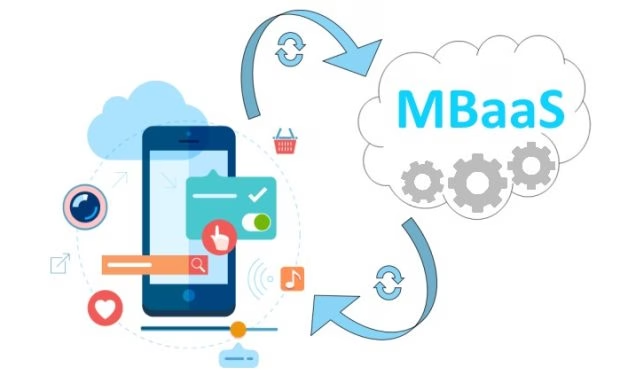
How To Choose The Best Mobile Backend As A Service?
Wondering how to choose the best mobile backend as a service? We've got the answers for you.
In this article
- How to choose among Mobile Backend as a Service Providers?
- A Comparison of Mobile Backend as a Service Providers
- Frequently Asked Questions on Mobile Backend as a Service
Mobile Backend as a Service (MBaaS) is a cloud computing service model that provides mobile and web app developers with a way to link their applications to backend cloud storage and APIs. It usually comes with features like user management, push notifications, social media integration, etc.
Let's now discuss how you can choose the best MBaaS options.
How to choose among Mobile Backend as a Service Providers?

You need to check for the following when you choose a mobile backend service provider for your mobile or web apps:

Get a complimentary discovery call and a free ballpark estimate for your project
Trusted by 100x of startups and companies like
- Ease of use is the most important.
- The provider must securely store the server-side code, files, databases, etc. on the cloud.
- It should provide a well-tested architecture for database and transaction processing capabilities required for a mobile app.
- Your provider must provide you with APIs to connect your app to the various cloud services you need.
- Ease of backend data management is important. The provider should provide the right processes, methods, and tools (PM&T) for this.
- Communication between users and servers should be secured.
- Excellent technical support is a must.
- Doing business with the provider must be easy!
Read the G2 MBaaS review for more details on the criteria.
A Comparison of Mobile Backend as a Service Providers
Before I start an exercise to compare providers, it’s important to note that Parse had been a leader in the MBaaS space. Several MBaaS providers took their inspiration from it, however, the company closed in 2017.
Google Firebase
Google acquired Firebase in 2014 and effectively made an entry into the growing MBaaS space with it. There are three categories into which we can categorize the features of Firebase, and these are ‘Develop', ‘Grow', and ‘Earn'.
The ‘Develop’ category offers the following:
- A database on the Cloud that you can set up quickly.
- Authentication services using OAuth, Google, and Facebook. There is a provision for custom services also.
- Cloud messaging including notification services.
- Petabyte-scale storage.
- High-quality hosting including ‘Content Delivery Network’ (CDN).
- Testing tools and environment.
- Crash reporting features.
The ‘Grow’ category features help you analyze your user interactions, so you can grow your user engagement. These are as follows:
- Analytics tailored to mobile and built on Google Analytics.
- Analytics for notification campaigns.
- Indexing of your app.
- Enables dynamic linking.
The ‘Earn’, i.e. the third category, is for advertising.
There is a free tier, which can be good news for you if you are starting small with your app. Check out their pricing on the Firebase website.
Apple CloudKit
Apple released it in 2015, and if you are looking for an iOS backend as a service, this is the one for you. It’s easy to integrate with other iOS apps when you use CloudKit.
The following services are included:
- User authentication.
- Databases: public, private, and shared.
- Storage services for your app assets.
- Scaling at the server-side.
- Automatic syncing with Apple platforms.
- Sharing of data.
There is a free tier, and you start to incur charges only beyond a threshold. The CloudKit dashboard lets you review the server activities of your app. It also enables you to monitor trends and measure parameters like user engagement and bandwidth usage.
CloudKit is very good when you are building simple apps. Check out the Apple CloudKit website for more details.
There are a few disadvantages with CloudKit, as follows:
Hire expert developers for your next project
1,200 top developers
us since 2016
- It provides no features to implement server-side logic.
- Users must sign in to iCloud to save data.
- Mobile app developers need to run application-specific logic on the client-side, which is a sub-optimal architectural approach.
- It supports iOS apps only.
Read more about the pros and cons of CloudKit in “How To Choose The Best Mobile Backend As A Service (MBaaS)”.
Interestingly, CloudKit is the second most popular MBaaS platform for iOS apps preceded by Firebase, according to a report.
Kinvey
Gartner Magic Quadrant 2018 names Kinvey a “Visionary” among Mobile App Development Platforms (MADPs).
Kinvey provides a broad set of features, as follows:
- Enterprise data mobilization: you can integrate easily with Enterprise or SaaS data stores.
- Many cloud-native services, ready-made solutions, and app templates help your development team increase their productivity.
- The security and compliance position of Kinvey is very strong. Your GDPR and HIPAA compliance will be easy with it. The platform supports data encryption at the client, in transit, and at rest.
- Robust cloud infrastructure.
- The platform boasts rich operational intelligence and Analytics.
- You can use Kinvey ‘Software Development Kit’ (SDK) or other development tools, and build native, hybrid, web, and ‘Internet of Things' (IoT) apps.
You have access to a set of comprehensive learning resources, which makes it easy to get started. Read more about Kinvey on their website.
Amazon Web Services for mobile
AWS MBaaS provides a wide set of services, as follows:
- Starter kits for developers to quickly start with their app.
- Provides multiple platform options, namely, iOS, Android, Web JS, and React Native.
- You can automate your DevOps pipeline to build, test, and deploy.
- Analytics to measure your user engagement.
- Email, SMS, and push notification integration.
- Secure Multi-Factor Authentication (MFA).
- Databases powered by Amazon DynamoDB.
- Robust Cloud infrastructure, where Amazon is a recognized leader. The infrastructure is highly scalable, and it includes CDN.
- Storage services.
- Deep learning.
- Amazon Pinpoint helps in comprehensive testing including ‘A/B Testing’.
AWS MBaaS isn’t easy to use, which is a disadvantage. They have a free tier. Read the AWS MBaaS website for more details.
SashiDo
SashiDo uses the Parse open-source code. A key advantage of this Mobile BaaS platform is that many developers were highly loyal to Parse, and they find SashiDo very familiar and easy to use.
It contains all the features that Parse had offered. Additionally, it offers the following:
- Cloud Code.
- Background jobs.
- Hosting NodeJS web and mobile applications.
- Database optimization.
- Push Notifications.
The company has an excellent customer support team, which is a great advantage. There’s no free tier, and the free trial period is for 14-days only.
However, I believe that the excellent platform and superior customer service, coupled with their exciting future development plans far outweigh the lack of a free tier. Read more on the SashiDo website.
Hire expert developers for your next project
Kumolos
Kumolos is a great MBaaS for mobile app development companies! In fact, these companies are their target customers, and their services are oriented towards these app development companies.
Below are their generic MBaaS platform features:
- Push Notifications.
- Crash reporting.
- Robust cloud.
- Reporting and Analytics.
- App Store Optimization (ASO).
However, in line with their target customer segment, they provide the following additional services:
- Agency console: If you are a mobile app development company, you will find this very useful. All your different clients’ apps are available all in one place. In fact, when you are delivering your sales pitch to a prospective client, you can showcase your success stories right on the Cloud!
- Client portal: This is for your clients, i.e. for whom you have developed mobile apps. A Content Management System (CMS) is available so that your clients can do minor content updates themselves, without having to engage you. They also can see their mobile devices usage, user engagement analytics, etc. Remember that this user engagement analytics is for their users! The client portal has your branding, which serves as another sales tool for you to engage your existing customers.
Kumolos has no free tier, and you can see why. They offer features-based pricing, which is easy to understand. Read “How to Build Your SaaS Pricing Model” to know more about features-based pricing.
Planning to use a Mobile Backend as a Service?
So, how do you build the best backend for a mobile app by selecting the right provider? Your context plays an important part here.
If you are a mobile app agency, Kumolos is an obvious choice. On the other hand, if you or your team were heavily invested in Parse, SashiDo could be your best bet.
Again, if you want to feel comfortable working with the market leader, Google Firebase is your choice. I recommend you analyze carefully the pros and cons before deciding on MBaaS and app development solutions.
DevTeam.Space has wide experience in developing cloud-based solutions for its clients via its expert software developer community. You can also partner with these experienced software mobile developers and project managers by filling out this quick form with your initial software project requirements.
Frequently Asked Questions on Mobile Backend as a Service
Back4app, Firebase, Express.js, Laravel, Django, etc. are common backend servers for mobile applications.
MBaaS is a cloud computing architecture that provides businesses with all the services they need to develop, test and run their mobile apps on the cloud. This leaves developers and project managers to focus on developing better apps and delivering a great user experience instead of managing the backend resources like storage, databases, networking, etc.
Reduced time to market, increased development speed, improved scalability, high performance, etc. are some of the main benefits of using a mobile backend as a service for your mobile applications.


